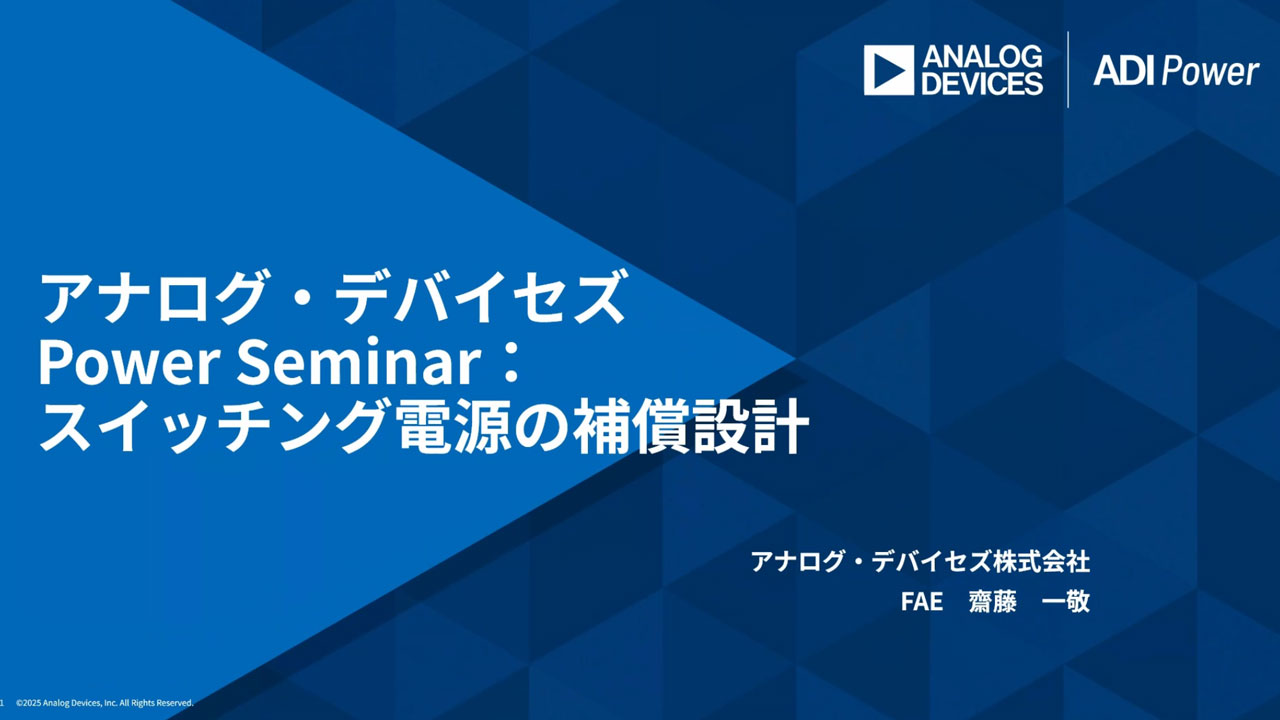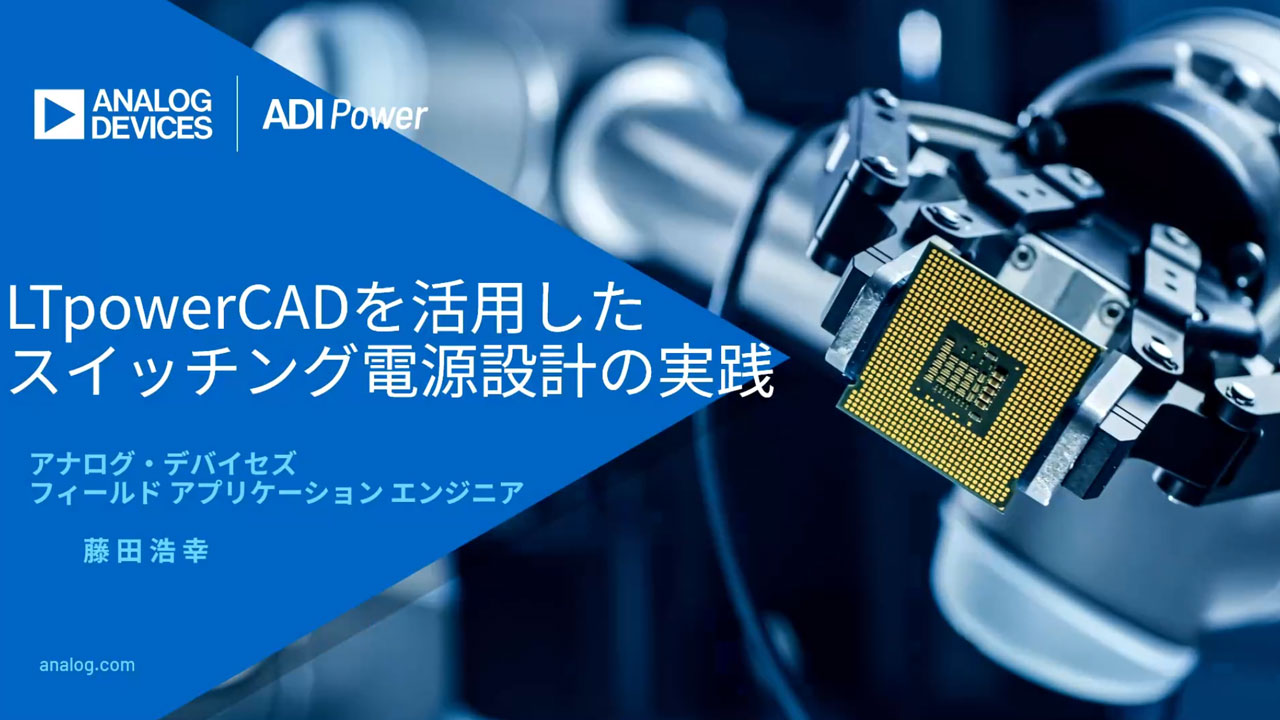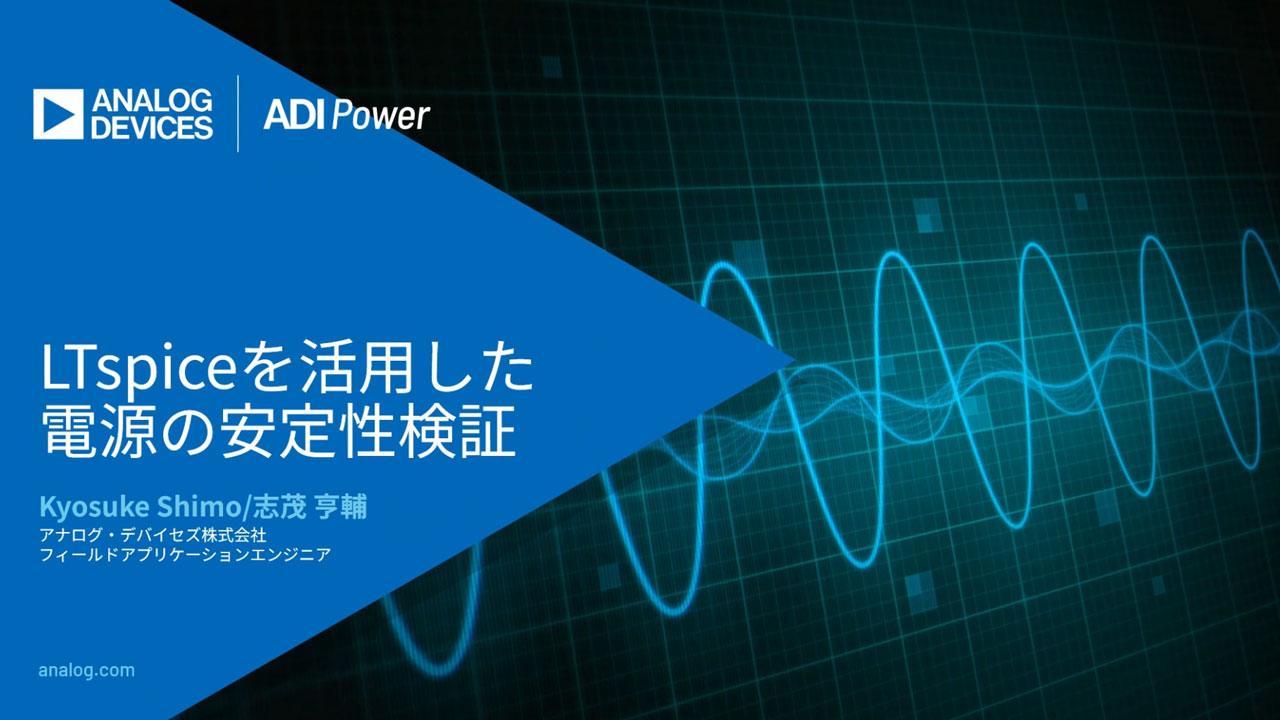高電圧に対応可能な非同期型の昇圧コントローラ、非常に高いEMI性能を実現
要約
本稿では、高電圧に対応可能な非同期型の昇圧コントローラICを紹介します。そのICは、ディスクリートのパワー・スイッチ、キャッチ・ダイオードと組み合わせて使用します。本稿では、その構成でもエミッション(妨害波)を非常に低く抑えられることを実証します。その中で、CISPR 25 クラス5で定められたエミッション規格を満たす2種類のリファレンス設計(評価用ボード)を紹介することにします。エミッションに関する規格を満たすためには、プリント基板のレイアウトに配慮することが非常に重要です。また、スイッチング動作のエッジ・レートを適切に制御することも必須となります。
はじめに
車載分野や産業分野で使用される電源システムを設計する際には、スイッチング電源(SMPS:Switch-mode Power Supply)から生じるエミッションを低減することが大きな目標になります。実際、SMPSからは多くのノイズが生じます。そのため、CISPRのエミッション規格を満たすのが難しいとされます。アナログ・デバイセズは、ここ10年間、SMPSのエミッションを低減するための取り組みを続けてきました。具体的には、電磁干渉(EMI)を容易かつ大幅に低減することに重点を置いて製品開発を進めてきました。本稿で紹介するのは、その成果として最初に実現された昇圧コントローラICです。そのICは、非同期型の制御機能を備えるものであり、外付けのパワー・スイッチと共に使用します。
モノリシック型のSMPS製品は、DC/DC変換のアプリケーションを実現する上で非常に便利なものだと言えます。そうしたIC製品には、パワー・コンポーネント、制御ループ、その他の機能が統合されており、必要な外付け部品の数は最小限で済みます。パワー・スイッチを内蔵したICを採用すれば、基板の設計/レイアウトを大幅に簡素化することが可能です。但し、外付けのパワー・スイッチを使用する場合と比べると、出力電力が低く抑えられてしまいます。つまり、設計の複雑さと出力電力の量がトレードオフの関係になります。また、パワー・スイッチを内蔵するICには、ホット・ループが小さく、エミッションを低く抑えられるという長所があります。その半面、大きな電力損失のすべてがICパッケージの限られたスペースに集中してしまうという短所があります。大電力/高周波/高電圧のシステムでは、熱性能に関する問題が生じる可能性があるということです。現実のアプリケーションでは、最大50Wもの電力を扱わなければならないケースは少なくありません。そうしたアプリケーションにモノリシック型のSMPS製品で対応するのは困難です。このことから、外付けのパワー・スイッチを使用するコントローラICも広く使われています。
昇圧コンバータについては、エミッションを抑えられる製品に対するニーズが高まっています。本稿で紹介する非同期型の昇圧コントローラ「LT8357」は、そのような要望に応えるために開発されました。同コントローラは、高電圧に対応可能な1つのパワー・スイッチを駆動する役割を担います。それにより、昇圧コンバータまたはSEPIC(Single-ended Primary Inductor Converter)を構成することが可能です。このような汎用性が実現されている点がLT8357の特徴の1つです。特に、車載システムで使用するSMPSについては、入力電圧範囲が広く、自己消費電流が少ないことが重要な要件になります。それだけでなく、スペクトラム拡散周波数変調(SSFM:Spread Spectrum Frequency Modulation)の機能も強く求められます。LT8357は、産業分野、車載分野、バッテリ駆動のシステムに最適な製品です。これを採用すれば、シンプルかつコンパクトで効率の高いソリューションを実現できます(図1)。
図1. LT8357の評価用ボード(EVAL-LT8357-AZ)の回路図。EMIが小さく、最高の性能が得られます。
従来、SMPSのエミッション性能には限界があると考えられていました。アナログ・デバイセズはその常識を覆すために、ここ数年間尽力し続けてきました。その成果の1つがSilent Switcher®(サイレント・スイッチャ)技術です。同技術を採用した製品では、実現し得るまさに最良のエミッション性能が得られます。Silent Switcherを適用した初のモノリシック型昇圧コンバータは「LT8336」です。この製品は2020年にリリースされました。Silent Switcherを採用した製品は、同期型で制御されるパワー・スイッチを内蔵しています。それらの製品では、スイッチングとホット・ループに起因するエミッションが最小限に抑えられています。その高い性能は、ホット・ループの縮小/統合を図るなど、様々な手法を適用した結果として実現されています1。
Silent Switcherのアーキテクチャは、エミッションを抑えるための方法の1つです。ただ、それが唯一の策だというわけではありません。非同期型/モノリシック型のレギュレータ製品の中には、パワー・スイッチが1個だけICのシリコン上に、またはパッケージ内に実装されているものがあります。その種の製品でも、エミッションを最小限に抑えることができます2。
レイアウトの重要性
SMPSのエミッションを低く抑えるためには、プリント基板のレイアウトに細心の注意を払わなければなりません。特にコントローラICを使用する場合にはこの点が重要です。パワー・スイッチを内蔵するモノリシック型のソリューションの場合、エミッションを低減するための手法があらかじめ適用されています。それに対し、外付けのパワー・スイッチとコントローラICを組み合わせて使用する場合、そうした手法が適用されていない状態になります。したがって、基板の設計者がレイアウトについて慎重に検討することで、エミッションを最小限に抑えなければなりません。具体的には、CISPR規格を満たせるようにすることが目標になるでしょう。ここでは、性能を最大化するためのヒントとして基板レイアウトの例を紹介することにします。図7に示したのが、エミッションを抑えるための最適なレイアウトの例です。一方、図8~図10に示したような不適切なレイアウトを行ってしまうと、エミッションを抑えるのが困難になります。
図2. EVAL-LT8357-AZのホット・ループ
図3. CISPR 25 クラス5に対応する伝導電圧エミッション試験の結果(その1)。EVAL-LT8357-AZの理想的なレイアウト(A)とホット・ループの大きいレイアウト(B)を比較しています。
図4. CISPR 25 クラス5に対応する伝導電圧エミッション試験の結果(その2)。EVAL-LT8357-AZの理想的なレイアウト(A)とスイッチ・ノードのプレーンが大きいレイアウト(C)を比較しています。
図5. CISPR 25 クラス5に対応する伝導電圧エミッション試験の結果(その3)。EVAL-LT8357-AZの理想的なレイアウト(A)とスイッチ・ノードにビアを設けたレイアウト(D)を比較しています。
図6. CISPR 25 クラス5に対応する放射エミッション試験の結果。EVAL-LT8357-AZの理想的なレイアウト(A)とスイッチ・ノードにビアを設けたレイアウト(D)を比較しています。

図7. 最適なレイアウト(A)。EVAL-LT8357-AZの例です。

図8. ホット・ループが大きいレイアウト(B)。EVAL-LT8357-AZの基板を改変したものです。

図9. スイッチ・ノードのプレーンが大きいレイアウト(C)。EVAL-LT8357-AZの基板を改変したものです。

図10. スイッチ・ノードにビアを設けたレイアウト(D)。EVAL-LT8357-AZの基板を改変したものです。
ホット・ループの管理
同期型のSMPSでは、ゲート・ドライバとパワー・スイッチをそれぞれ2つ使用します。制御ロジックによって、それらを同期した状態で動作させます。この方式では、キャッチ・ダイオード(非同期)で生じる潜在的な伝導損失が最小限に抑えられます。ただ、このような同期型のSMPSを実現するには複雑な機能が必要です。例えば、シュートスルー電流を防止するためには、ゲートを駆動するタイミングに関する要件を満たすための機能を用意しなければなりません。また、IC上には、ハイサイドのゲート・ドライバ用のスペースを追加する必要があります(その分、コストは増大します)。
それに対し、非同期型の昇圧コンバータではメインのスイッチと出力用のキャッチ・ダイオードをそれぞれ1つ使用します。必要なゲート・ドライバの数も1つだけです。パワー・スイッチとキャッチ・ダイオードの動作に関してブランキング時間を設ける必要もありません。但し、それら2つの部品のスイッチング動作には大電流が伴います。エミッションを抑制したい場合、そのことが問題になる可能性があります。この潜在的な課題を軽減するための最良の方法は、昇圧コンバータのホット・ループの大きさを最小限に抑えることです。ホット・ループは、メインのスイッチ、キャッチ・ダイオード(または同期動作するスイッチ)、出力コンデンサの3つの部品から成ります。また、通常(LT8357の場合など)は、スイッチのピーク電流を検出するためのセンス抵抗もホット・ループの一部となります(図2)。更に、SEPICでは、2つの巻線間のカップリング・コンデンサもホット・ループに含まれます。ホット・ループのサイズが大きい場合、配線パターンのインダクタンスが問題になります。その余分なインダクタンスが大電流を伴うスイッチング・パスに付加されることによって、各ノードに電圧スパイクが生じる可能性があるからです。それらは、エミッションの重大な原因になります。ここで、図3をご覧ください。ホット・ループを適切に管理すれば、伝導電圧の試験においてエミッションを適切なレベルまで低減できることがわかります。
スイッチ・ノードのプレーンの縮小
エミッションの小さいボードを実現するためには、スイッチ・ノードのプレーンのサイズを縮小することも重要です。そのプレーンには、スイッチのドレイン、インダクタの片端、キャッチ・ダイオードのアノードが含まれます。放熱の観点から、このプレーンのサイズを大きくしたいと考える方もいるかもしれません。しかし、そのような設計を採用すると、エミッションが増大する可能性があります。図4を見れば、スイッチ・ノードのプレーンを縮小することにより、伝導性電圧エミッションを低減できることがわかります。
スイッチ・ノードのプレーンを1つのレイヤに収める
スイッチ・ノードのプレーンを可能な限り1つのレイヤに収めるのは非常に重要なことです。サイズに関する制約から、インダクタを片面に配置し、スイッチをもう一方の面に配置したくなるケースもあるかもしれません。そのためには、スイッチ・ノードのプレーンにいくつかのビアを設けて別のレイヤまで貫通させ、再び元のレイヤに戻す必要があります。確かに、この手法を採用すれば基板面積を節約できるかもしれません。しかし、エミッションの増大につながることには注意が必要です。スイッチ・ノードのビアは、追加のアンテナとして機能します。それにより、ノイズやその他の放射成分が生じます。それらの成分は、エミッションの測定に用いるアンテナで簡単に検出できるレベルに達します。図5、図6を見れば、スイッチ・ノードのビアによってエミッションに大きな影響が及ぶことがわかります。
SSFMにより、最高2MHzのスイッチング周波数に対応
半導体の微細化が進んだことで、より多くの機能が1つのデバイスに集積されるようになりました。また、昨今のICでは、電力に関する要件に、より小さな面積で対応できるようになっています。そうした状況を受けて、電源をはじめとする回路の実装面積を縮小したいというニーズが高まっています。インダクタは相対的に見て非常に大きな部品であり、基板面積の縮小を図る上での制約になります。よく知られているように、SMPSに必要なインダクタンスの値はスイッチング周波数に反比例します。例えば、200kHzのスイッチング周波数に対して10μHのインダクタを必要とする設計があったとしましょう。その場合、2MHzのスイッチング周波数を使用すれば、電力に関する要件を維持しつつインダクタの値を1μHに抑えることができます。LT8357の場合、最高2MHzまでのスイッチング周波数を使用可能です。このような柔軟性を備えることから、インダクタのサイズを大幅に縮小できる可能性があります。そうすれば、スイッチ・ノードのプレーンも縮小できます。その結果、エミッションの面でもメリットが得られるはずです。
スイッチング周波数として2MHzを使用できれば、もう1つの重要なメリットを享受することが可能になります。CISPR 25では、530kHzから1.8MHzまでの帯域を対象として制限が課されています。この帯域は、AMラジオ帯を含む中波(MW)帯として知られています。CISPRの規格に準拠しやすくするためには、この範囲内のスイッチング周波数を使用するべきではありません。スイッチング周波数を2MHzに設定できれば、この帯域を完全に避けられます。つまり、同規格に準拠しやすくなります。なぜなら、エミッションの基本周波数が2MHzとなり、その高調波はより高い周波数に現れることになるからです。また、より低い周波数において上限値を下回るレベルまでエミッションを減衰させるためには、低周波向けのフィルタが必要です。スイッチング周波数を2MHzに設定すれば、そうしたかさばるフィルタが不要になります。
2MHzといった高いスイッチング周波数を選択したのにもかかわらず、基本周波数と高調波がCISPR規格の上限値を超えてしまうこともあるはずです。その対策として、LT8357はSSFM機能を搭載しています。同機能は、CISPR 25で定められたエミッションの規格に合格するための非常に有用な手段です。LT8357は、トライアングル・スペクトラム拡散を使用することで、設定周波数から最大19%高いレベルまでスイッチング周波数をインテリジェントに拡散させます。この手法は、最低周波数と最高周波数におけるエミッションのピークを低減する効果をもたらします。図11を見れば、SSFM機能をオン/オフすることで、エミッションのスペクトラムにどのような違いが出るのかがわかります。同機能を使用すればエミッションが低減され、CISPR規格を満たすことが容易になります。
図11. 放射EMI試験の結果(その1)。LT8357の評価用ボードを2MHzのスイッチング周波数で動作させ、SSFM機能がオンの場合とオフの場合の平均放射EMIの最大値を比較しました。
スイッチ・ノードのエッジ・レートの制御、スプリット・ゲート・ドライバの効果
スイッチ・ノードの電圧は、各サイクルにおいて0VとVOUTの間を遷移(立ち上がりと立下がり)します。この動作が周波数の高いエミッションが発生する原因の大部分を占めます。モノリシック型のSMPSでは、ICの設計によってスイッチ・ノードの立ち上がりと立下がりの特性が決まります。ユーザはその特性を制御することはできません。とはいえ、モノリシック型のICの多くは、エミッションを最小限に抑えるためにスイッチングのエッジの挙動が制御されるように設計されています。
コントローラICを使用する場合、パワー・スイッチとしては外付けのものを使用します。コントローラICからゲートを駆動するための信号が出力され、外付けのスイッチが制御されることになります。優れたコントローラ製品は、スイッチのターンオン動作を高い精度で制御し、そのドレイン電圧の立ち上がりと立下がりを効果的に管理します。スイッチの立ち上がり動作と立下り動作を適切に制御すれば、周波数の高い放射エミッションを大幅に低減できます。また、ゲート抵抗(通常5Ω程度)を使用すれば、周波数の高い放射エミッションを更に低減することが可能になります。但し、そうすると効率が低下します。ターンオン/ターンオフにかかる時間が長くなり、スイッチング損失が増加するということです。
従来、ユーザはゲートのターンオンとターンオフの両方に対し、1つの抵抗を適用して制御することしかできませんでした。それに対し、LT8357では独自のスプリット・ゲート・ドライバ機能を利用できます。スプリット・ゲート・ドライバを使用すれば、ゲートのターンオンとターンオフを独立した形で正確に制御することが可能になります。実験の結果、LT8357の場合、ゲートのターンオンはターンオフと比べ、放射エミッションに対してかなり大きな影響を及ぼすことがわかっています。そのため、どちらかのエッジが遅くなるよう正確に制御できることは大きなメリットになります。プルアップ用にはゲート抵抗を適用し、プルダウン用にはゲート抵抗を適用しないという選択を行うことで、高い効率を維持したままエミッションを最小限に抑えることが可能になります。
ここで図12をご覧ください。これは、EVAL-LT8357-AZに対して様々な値のゲート抵抗を適用した場合のエミッションの評価結果です。これを見ると、ゲート抵抗は主に400MHz~500MHzの範囲のエミッションに影響を与えることがわかります。
図12. 放射EMI試験の結果(その2)。ゲート抵抗の値を変更し、EVAL-LT8357-AZの平均放射エミッションの最大値を比較しました。青色のプロットはRP = RN = 5.1Ω、空色のプロットはRP = 5.1Ω、RN = 0Ω、紫色のプロットはRP = RN = 0Ω、赤色のプロットはRP = 0Ω、RN =5.1Ωの条件で取得しました。
また、プルダウン用の抵抗は最小限の影響しか与えないことも見てとれます。一方、プルアップ用の抵抗はエミッションの削減に与える影響が大きいことがわかります。したがって、電力損失とエミッションを最適な形で削減するには、プルアップ用の抵抗として5Ωの抵抗を使用し、プルダウン用の抵抗は使用しない(ショートさせる)ことが推奨されるという結論が得られます(図13)。
図14は、2MHzのスイッチング周波数を使用するための改変を加えたEVAL-LT8357-AZの回路図です。この回路には、プルアップ用のものとして5.1Ωの抵抗を追加しています。一方、プルダウン用の抵抗は使用していません。
図13. 放射EMI試験の結果(その3)。プルアップ用のゲート抵抗を付加した場合と付加しない場合の平均放射エミッションの最大値を比較しています。この例では、LT8357によって12Vから24Vへの昇圧を行っています。スイッチング周波数は2MHz、負荷電流は2Aです。
図14. 2MHzのスイッチング周波数を使用するための改変を加えたEVAL-LT8357-AZの回路図
電力損失の削減
表1は、図14の回路において、入力部と出力部のEMI用フィルタをショートさせた場合の効率の違いを示したものです。入力が12V、出力が24V/2A、スイッチング周波数が2MHzの昇圧コンバータを構成した場合の結果をまとめています。ご覧のように、電力を最大限に節約できるのは、プルダウン用の抵抗RNを0Ωに設定した場合です。スイッチングによる電力損失は以下の式で求められます。
| 2MHzで動作させるための改変を行ったEVAL-LT8357-AZ | RN | ||
| 0 | 5 | ||
| RP | 0 | 95.1% | 94.2% |
| 5 | 95.0% | 93.9% | |
ここで、RGPは、データシートの「GATE Pull-Up Resistance(GATEプルアップ抵抗)」の項に記載されている値、ユーザが選択したプルアップ用のゲート抵抗の値、パワー・スイッチのデータシートに記載されているゲート抵抗RGの値を組み合わせたものです。RGNの値も同様の組み合わせによって決まりますが、プルダウン用のゲート抵抗の値も含めます。Ciss、Cgd、Vgp、VTHの値は、すべてパワー・スイッチのデータシートに記載されています。
ゲート・ドライバとパワー・スイッチのゲートの間に存在する抵抗は、電力損失に直接影響を及ぼします。すべての計算を実施すると、ターンオフに伴うスイッチング損失はかなり大きいことがわかります。また、スイッチがオフしている際の電力損失の式から、同じゲート抵抗を使用している場合には、より大きな損失が生じることがわかります。ターンオフする際にスイッチに流れる電流の方が多いため、そのような結果になります。ゲートのターンオフはエミッションには大きな影響を及ぼしません。そのため、GATENピンからスイッチのゲートまでを0Ωの抵抗で接続する(つまりショートさせる)ことで、効率とエミッションを最適化できます。例えば、スイッチング周波数が2MHzの場合、プルダウン用の抵抗を排除するだけで効率が数%向上します。この効果を軽視することはできません。スプリット型のゲート抵抗を使用すれば、余分なゲート抵抗によって効率を低下させることなく、エミッションを低減することが可能になります。
改変後の評価用ボードの性能
改変前のEVAL-LT8357-AZは、LT8357を使用して昇圧動作を実現します。200kHzのスイッチング周波数で動作させた場合に高いEMI性能が得られるように設計されています。この評価用ボードのインダクタとしては、サイズが8mm×8mm×8mmの比較的大きなものを使用しています。しかし、このインダクタのサイズでは大きすぎるというケースもあるでしょう。その場合、電圧や電力の仕様は維持したまま、スイッチング周波数を2MHzに高めることで、より小さなインダクタを使用できるようになります。その場合のボードの改変は容易です。前掲の図14に示したように変更を加えることで、インダクタのサイズを大幅に縮小することができます。具体的には、8mm×8mm×8mmのインダクタ(XAL8080-103MEB)から、より小型の4mm×4mm×3mmのインダクタ(XGL4030-102)に変更することが可能です。また、出力部のかさばるハイブリッド・ポリマー・コンデンサも不要になり、入力部のEMI用フィルタの小型化も図れます。このような改変により、12Vの入力、24V/2Aの出力という条件を維持しつつ基板上の実装スペースを大幅に削減できます。図15~図18に、2MHzのスイッチング周波数を使用するために改変したボードのエミッション性能を示しました。ご覧のように、CISPR 25 クラス5の規格を満たしています。
図15. CISPR 25 クラス5に対応する平均伝導電圧エミッション試験の結果。2MHzのスイッチング周波数を使用するよう改変したEVAL-LT8357-AZを対象としています。
図16. CISPR 25 クラス5に対応するピーク伝導電圧エミッション試験の結果。2MHzのスイッチング周波数を使用するよう改変したEVAL-LT8357-AZを対象としています。
図17. CISPR 25 クラス5に対応する平均放射エミッション試験の結果。2MHzのスイッチング周波数を使用するよう改変したEVAL-LT8357-AZを対象としています。
図18. CISPR 25 クラス5に対応するピーク放射エミッション試験の結果。2MHzのスイッチング周波数を使用するよう改変したEVAL-LT8357-AZを対象としています。
まとめ
LT8357は、エミッションを抑えられるように設計された昇圧コントローラ製品です。この12ピンのICは、豊富な機能と使いやすさを提供します。設計が複雑すぎることも、単純すぎることもありません。同期型で制御するパワー・スイッチのような不要な機能は搭載しておらず、合理的な設計が行われていると言えます。一方で、高い効率とエミッション性能を維持するために十分な機能を搭載しています。実際、同ICは多くの機能を備えています。ただ、同製品を使用する回路の設計は容易です。表2に、エミッションを低く抑えた昇圧コンバータ製品群の概要を示しました。LT8357は、この表に追加するにふさわしい完全な製品だと言えます。
| VIN の範囲 | SW1 | SW2 | FSW | 他のトポロジ | IC Package | AEC-Q100 | 特記事項 | |
| LT8357 | 3V~60V | コントローラ | X | 100kHz~2MHz+ SSFM | SEPIC、フライバック | 12ピンMSOP | 近く対応 | 近く対応IQは8μA、Burst Mode®、スプリット・ゲート |
| LT8336 | 2.7V~40V | 2.5A、40V | 2.5A、40V | 300kHz~3MHz+ SSFM | X | 16ピンLQFN(3mm×3mm) | ✓ | IQは4μA、Burst Mode、PassThru™ |
| LT8337 | 2.7V~28V | 5A、28V | 5A、28V | 300kHz~3MHz+ SSFM | X | 16ピンLQFN(3mm×3mm) | — | IQは4μA、Burst Mode、PassThru |
| LT8362 | 2.8V~60V | 2A、60V | X | 300kHz~2MHz+ SSFM | SEPIC、反転 | 10ピンDFN(3mm×3mm)、16(12)ピンMSOP | ✓ | IQは9μA、Burst Mode |
| LT8333 | 2.8V~40V | 3A、40V | X | 300kHz~2MHz+ SSFM | SEPIC、反転 | 10ピンDFN(3mm×3mm) | — | IQは9μA、Burst Mode |
| LT8364 | 2.8V~60V | 4A、60V | X | 300kHz~2MHz+ SSFM | SEPIC、反転 | 12ピンDFN(4mm×3mm)、16(12)ピンMSOP | ✓ | IQは9μA、Burst Mode |
| LT8334 | 2.8V~40V | 5A、40V | X | 300kHz~2MHz+ SSFM | SEPIC、反転 | 12ピンDFN(4mm×3mm) | — | IQは9μA、Burst Mode |
現在、高電圧と大電流に対応可能でエミッション性能に優れる昇圧コンバータに対する需要が高まっています。新世代の昇圧コントローラであるLT8357は、そうしたニーズに応えるために特別に設計されたものです。同ICは、高電圧に対応可能な単一のパワー・スイッチを駆動する非同期型のコントローラです。また、昇圧コンバータとSEPICの両方を構築できるだけの汎用性を備えています。加えて、高いカスタマイズ性も有しています。その電流モードのアーキテクチャにより、調整/同期が可能な100kHz~2MHzの固定スイッチング周波数を用いた動作を実現できます。19%の周波数範囲に対応するトライアングルSSFM機能を利用すれば、より高いEMI性能が得られます。同機能は、有効/無効に切り替えることが可能です。5Vに対応するスプリット・ゲート・ドライバは、エミッション性能と効率のトレードオフを最適化するための有用なツールとして機能します。パワー・スイッチとしては、NチャンネルのMOSFETまたは窒化ガリウム(GaN)FETを使用可能です。LT8357は、3V~60Vという広い入力電圧範囲に対応します。また、自己消費電流IQはわずか8μAです。更に、専用のPGOODピンも備えています。同ICは、産業用システム、車載システム、バッテリ駆動のシステムに最適な製品です。これを採用すれば、シンプルかつコンパクトで効率に優れたソリューションを実現することができます。
参考資料
1Tony Armstrong「低ノイズの電源を容易に実現可能にするSilent Switcher」Analog Dialogue、Vol. 53、2019年4月
2Keith Szolusha、Kevin Thai「キャッチ・ダイオードを使用する非同期方式の昇圧コンバータでは、高いEMI性能を実現することはできないのか?」Analog Devices、2022年3月
3「Power MOSFET Basics: Understanding Gate Charge and Using It to Assess Switching Performance(パワーMOSFETの基礎:ゲートの電荷について理解し、スイッチング性能の評価に活かす)」Vishay、2016年2月
4「How to Select the Right CoolMOS and Its Power Handling Capability(CoolMOSの電力処理能力を把握し、適切な製品を選択する)」Infineon Technologies、2002年
5BSZ0500NSI、Infineon Technologies、2021年
6BSZ0506NS、Infineon Technologies、2021年
7George Lakkas「MOSFET Power Losses and How They Affect Power-Supply Efficiency(MOSFETの電力損失、それが電源の効率に及ぼす影響)」Texas Instruments、2015年



































